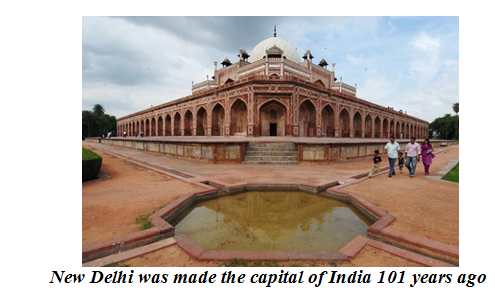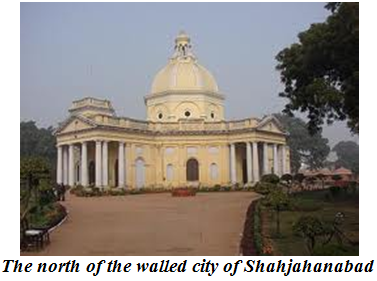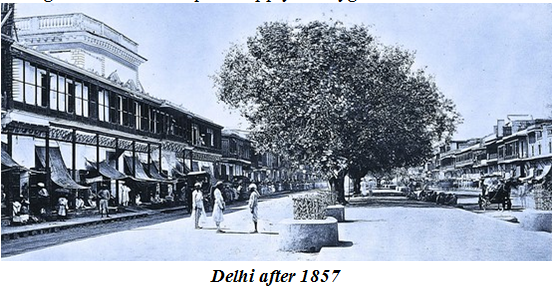
The Making of New Delhi
Colonialism and The Story of the Imperial Capital of Class 8
In 1803, the British gained control of Delhi after defeating the Marathas. Since the capital of British India was Calcutta, the Mughal emperor was allowed to continue living in the palace complex in the Red Fort. The modern city developed only after 1911, when Delhi became the capital of British India.

DEMOLISHING A PAST
- Before 1857, in Madras, Bombay or Calcutta, the living spaces of Indians and the British were sharply separated. Indians lived in the " Black" areas, while the British lived in well-laid-out " White" areas. In Delhi, the British lived along with the wealthier Indians in the Walled City. The British learned to enjoy Urdu/Persian culture and poetry and participated in local festivals. The establishment of the Delhi College in 1792 led to a great intellectual flowering in the sciences as well as the humanities, largely in the Urdu language. The period from 1830 to 1857 is often termed as a period of the Delhi renaissance.
- All this changed after 1857. Delhi remained under rebel control for four months. When the British regained the city, they embarked on a campaign of revenge and plunder. They killed the helpless and burned houses. To prevent another rebellion, the British exiled Bahadur Shah to Burma (now Myanmar), dismantled his court, razed several of the palaces, closed down gardens and built barracks for troops in their place.
- The British wanted Delhi to forget its Mughal past. The area around the Fort was completely cleared of gardens, pavilions, and mosques. The British wanted a clear ground for security reasons. Mosques, in particular, were either destroyed or put to other uses. One-third of the city was demolished, and its canals were filled up.
- In the 1870s, the western walls of Shahjahanabad were broken to establish the railway and to allow the city to expand beyond the walls. The British now began to live in civil line area away from the Indians in the Walled City., The Delhi College was turned into a school, and shut down in 1877.

PLANNING A NEW CAPITAL
- The British were fully aware of the symbolic importance of Delhi. In 1877, Viceroy Lytton organized a Durbar to acknowledge Queen Victoria as the Empress of India. The grand Durbar was held in Delhi because during the revolt, the British had realised that the Mughal emperor was still important to the people and they saw him as their leader. It was therefore important to celebrate British power with pomp and show in the city the Mughal emperors had earlier ruled, and the place which had turned into a rebel stronghold in 1857.
- In 1911, when King George V was crowned in England, a Durbar was held in Delhi to celebrate the occasion. The decision to shift the capital of India from Calcutta to Delhi was announced at this Durbar.
- New Delhi was constructed as a 10-square-mile city on Raisina Hill, south of the existing city. Two architects, Edward Lutyens and Herbert Baker, were called on to design New Delhi and its buildings. The government complex in New Delhi consisted of a two-mile avenue, Kingsway (now Rajpath), that led to the Viceroy's Palace (now Rashtrapati Bhavan), with the Secretariat buildings on either sides of the avenue. The features of these government buildings were borrowed from different periods of India's imperial history. But the overall look was Classical Greece (fifth century BC). The new buildings had to assert British importance: that is why the architect made sure that the Viceroy's Palace was higher than Shah Jahan's Jama Masjid.
- New Delhi took nearly 20 years to build. The idea was to build a city that was contrast to Shahjahanad. There were to be no crowded mohalas, no narrow by-lanes. In New Delhi, there were broad, straight streets lined with sprawling mansions. The architects wanted New Delhi to represent a sense of law and order The new city also had to be a clean and healthy space. This meant that New Delhi had to have better water supply, sewage disposal and drainage facilities than the Old City. It had to be green, with trees and parks ensuring fresh air and adequate supply of oxygen.

LIFE IN THE TIME OF PARTITION
- The Partition of India in 1947 led to a massive transfer of populations on both sides of the new border. As a result, the population of Delhi swelled, the kinds of jobs people did changed, and the culture of the city became different.
- Days after Indian Independence and Partition, fierce rioting began. As streams of Muslims left Delhi for Pakistan, their place was taken by equally large numbers of Sikh and Hindu refugees from Pakistan.
- Refugees roamed the streets of Shahjahanabad, searching for empty homes to occupy. At times they forced Muslims to leave or sell their properties. Over two-thirds of the Delhi Muslims migrated. Almost 44,000 homes were abandoned. Terrorised Muslims lived in makeshift camps till they could leave for Pakistan.
- Delhi became a city of refugees. Nearly 500,000 people were added to Delhi's population. Most of these migrants were from Punjab. Some got the opportunity to occupy residences that had been vacated; others were housed in refugee colonies. New colonies such as Lajpat Nagar and Tilak Nagar came up at this time. Shops and stalls were set up to cater to the demands of the migrants schools and colleges were also opened.
- The skills and occupations of the refugees were quite different from those of the people they replaced. The new migrants coming to Delhi were rural landlords, lawyers, teachers, traders and small shopkeepers.They had to take up new jobs as hawkers, vendors, carpenters and ironsmiths. Many however, prospered in their new businesses.
- The large migration from Punjab changed the social milieu of Delhi. An urban culture largely based on Urdu was overshadowed by new tastes and, sensibilities, in food, dress and the art.
🔥 Trending Blogs
Talk to a counsellorHave doubts? Our support team will be happy to assist you!

Check out these Related Articles
Free Learning Resources
PW Books
Notes (Class 10-12)
PW Study Materials
Notes (Class 6-9)
Ncert Solutions
Govt Exams
Class 6th to 12th Online Courses
Govt Job Exams Courses
UPSC Coaching
Defence Exam Coaching
Gate Exam Coaching
Other Exams
Know about Physics Wallah
Physics Wallah is an Indian edtech platform that provides accessible & comprehensive learning experiences to students from Class 6th to postgraduate level. We also provide extensive NCERT solutions, sample paper, NEET, JEE Mains, BITSAT previous year papers & more such resources to students. Physics Wallah also caters to over 3.5 million registered students and over 78 lakh+ Youtube subscribers with 4.8 rating on its app.
We Stand Out because
We provide students with intensive courses with India’s qualified & experienced faculties & mentors. PW strives to make the learning experience comprehensive and accessible for students of all sections of society. We believe in empowering every single student who couldn't dream of a good career in engineering and medical field earlier.
Our Key Focus Areas
Physics Wallah's main focus is to make the learning experience as economical as possible for all students. With our affordable courses like Lakshya, Udaan and Arjuna and many others, we have been able to provide a platform for lakhs of aspirants. From providing Chemistry, Maths, Physics formula to giving e-books of eminent authors like RD Sharma, RS Aggarwal and Lakhmir Singh, PW focuses on every single student's need for preparation.
What Makes Us Different
Physics Wallah strives to develop a comprehensive pedagogical structure for students, where they get a state-of-the-art learning experience with study material and resources. Apart from catering students preparing for JEE Mains and NEET, PW also provides study material for each state board like Uttar Pradesh, Bihar, and others
Copyright © 2025 Physicswallah Limited All rights reserved.
Get App



